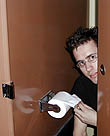|
|
This topic comprises 3 pages: 1 2 3
|
|
Author
|
Topic: Analog Soundtrack - MONO ??
|
|
|
|
|
Peter Mork
Expert Film Handler

Posts: 181
From: Newton, MA, USA
Registered: Jun 2002
|
 posted 11-28-2003 02:26 AM
posted 11-28-2003 02:26 AM




Right, it's more a matter of standardization than anything else. They COULD use a single, wider track - I have run such older tracks and the stereo head had no trouble with them.
There was a reissue of Citizen Kane in 1991 which (apparently) used the original printing element of the mono track, if I recall it right. Oddly, for part of one of the early reels, one side of this track was blacked out, who knows why - maybe the negative got pinhole damage or something, and this was their way of correcting it. A mono head presumably wouldn't have a problem with this, other than a drop in level. But my stereo processor didn't like this at all, and went haywire. I would've expected to hear sound from one side only, but instead it chose to put the sound front-center, with a delayed reverb coming from both side channels - very disconcerting. Perhaps one of our experts in surround matrixing can explain this.
| IP: Logged
|
|
|
|
|
|
|
|
|
|
|
|
Christopher Seo
Jedi Master Film Handler

Posts: 530
From: Los Angeles, CA
Registered: Jun 99
|
 posted 11-28-2003 09:04 AM
posted 11-28-2003 09:04 AM




Nate, to sum up what others have said, I think it comes down to:
(1) Labs use the same equipment to print mono tracks as stereo tracks, for efficiency;
(2) The dual-bilateral (i.e., two tracks, each with modulation on both sides) track scheme has advantages of lower distortion and better tracking which apply to mono as well.
The "Citizen Kane" print I ran last year was similar to what Peter described, a dual-unilateral (or RCA duplex?) track with Rt missing most of the time, but not all of the time. It came and went, leading me to think this was somehow intentional, since the (presumably original) leaders said "Regular Standard Track / Play At 6 dB Above Average RKO Level". If anyone has more information on the nature of this and Orson Welles' intentions, I'd be most interested. There wasn't (and shouldn't be) a problem playing this back on stereo equipment as Lt and Rt are simply summed to center. Mono tracks should never be played back through a stereo format due to the noise reduction which would act as an expander.
The print of "Kane" we got this year, however, was standard dual-bilateral mono. I think the leaders still had the "+6 dB" recommendation, though.
| IP: Logged
|
|
|
|
|
|
|
|
|
|
|
|
Joe Schmidt
Expert Film Handler
Posts: 172
From: Billings, Montana, USA
Registered: Apr 2001
|
 posted 11-28-2003 12:21 PM
posted 11-28-2003 12:21 PM




In the earlier days of optical film recording, quite a number of different formats were used. In my own personal opinion, one of the very best was the bilateral variable-area (single-line) used by RCA, and it was capable of producing stupendous sound recordings with high output and solid clean deep lows; mono of course. This is commonly seen on both 16mm and 35mm prints older prints, as mentioned by Darryl in his post. Thousands of features world-wide were done in this system.
Such prints, if reproduced on a custom sound system or one of the better theatre systems all-tweaked-up properly such as the Century/Altec tube systems circa-1950s, are capable of producing sound so good that on hearing it you’d think you were listening to a mag track.
During the entire period from about 1930 until the switch over to mag film recording, it was a fact that optical recordings on 35mm film was potentially the best recording system if done properly since at sound speed film runs at about 17ips, better than tape at 15ips. Of course many excellent master recordings on 16” transcriptions at 33-1/3 rpm also survive and can be heard on the many reissue CDs produced by Rhino and other labels, after being carefully reproduced with special styli and run thru the Cedar noise-reduction system.
The “Gold Diggers” films are an example of very good surviving 30s-era recordings. In fact I have a “Disco-LP” of the Lullaby On Broadway big dance number, about 10 minutes on a 12” LP at 45-rpm. Amazing. A bit surprising for this to have turned up as a disco issue but apparently lotsa folks liked it.
Citizen Kane and Yankee Doodle Dandy are excellent examples of RCA sound at its best, and Yankee won the Academy Award for Best Sound... you can hear how good it was/is by picking up the DVD and reproduce thru the best system you can find.
Sometimes in older features you will see several different optical formats appearing as it goes along. One example is “The Day the Earth Stood Still.” There is no particular “why” to this other than that different optical recorders happened to be used for various parts of the optical sound negative.
Peter Mork recalls seeing a print with “one side of the track blacked out.” I cannot say for sure without being able to look at the print, but it could have been that a section was recorded in the “unilateral variable-area” system. This is often seen in features from the 30s and 40s. Nothing has been blacked out, it’s just what that system looks like on the prints.
Michael mentions tracks recorded out of phase. There also were some “push-pull” recordings, a RCA system, but it didn’t catch on too much. Soundheads were produced with a switch for “PP” or “Normal” and a special photo-electrical cell was required.
Long out of print, the Audio Cyclopedia by Howard M. Tremaine has a meaty chapter on optical film recording with lots of pictures. It’s heavy going technically, as is the entire book; but remains one of my most cherished reference volumes.
| IP: Logged
|
|
|
|
All times are Central (GMT -6:00)
|
This topic comprises 3 pages: 1 2 3
|
Powered by Infopop Corporation
UBB.classicTM
6.3.1.2
The Film-Tech Forums are designed for various members related to the cinema industry to express their opinions, viewpoints and testimonials on various products, services and events based upon speculation, personal knowledge and factual information through use, therefore all views represented here allow no liability upon the publishers of this web site and the owners of said views assume no liability for any ill will resulting from these postings. The posts made here are for educational as well as entertainment purposes and as such anyone viewing this portion of the website must accept these views as statements of the author of that opinion
and agrees to release the authors from any and all liability.
|

 Home
Home
 Products
Products
 Store
Store
 Forum
Forum
 Warehouse
Warehouse
 Contact Us
Contact Us




 Printer-friendly view of this topic
Printer-friendly view of this topic





![[Razz]](tongue.gif)













